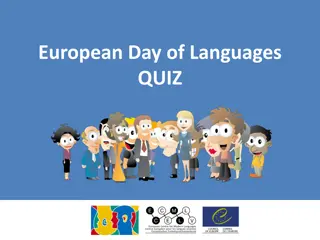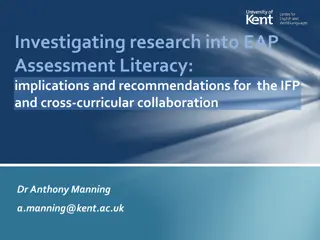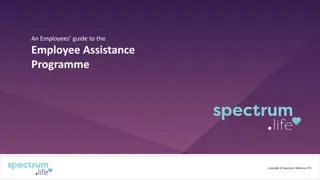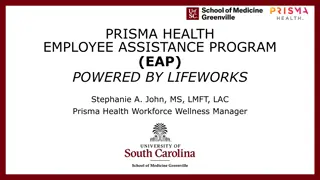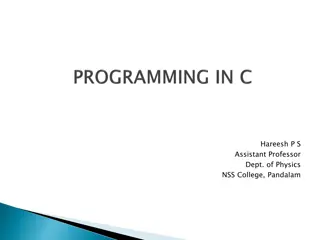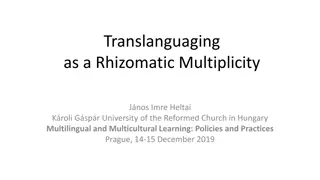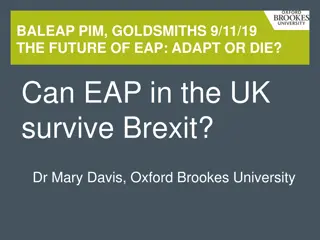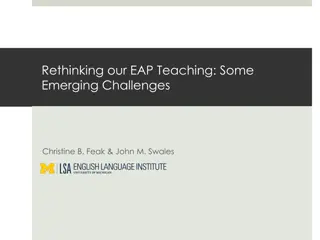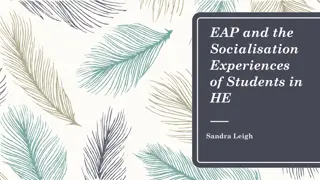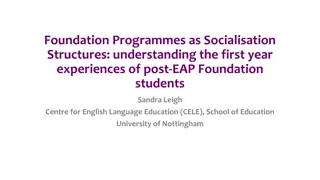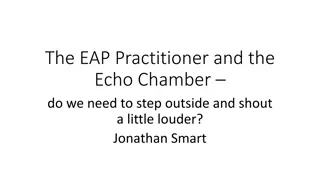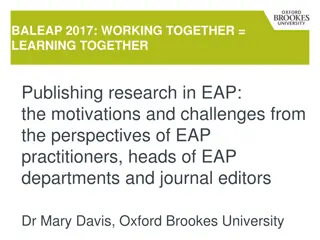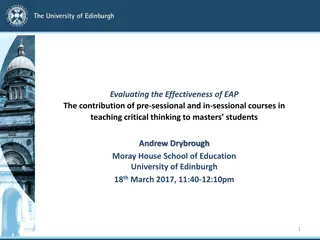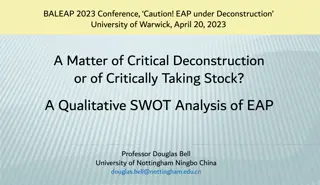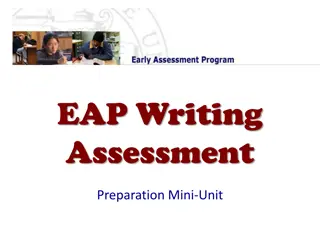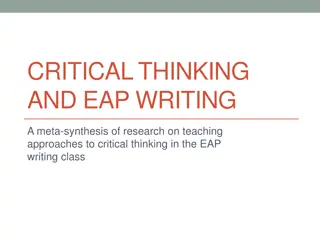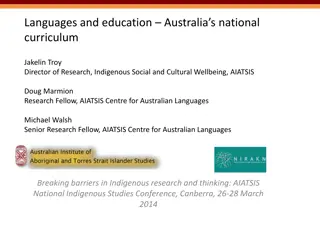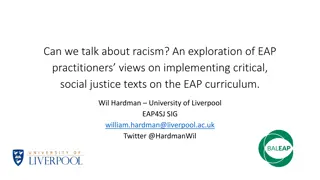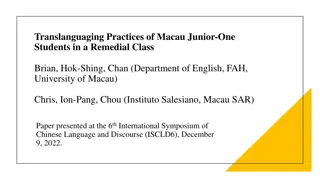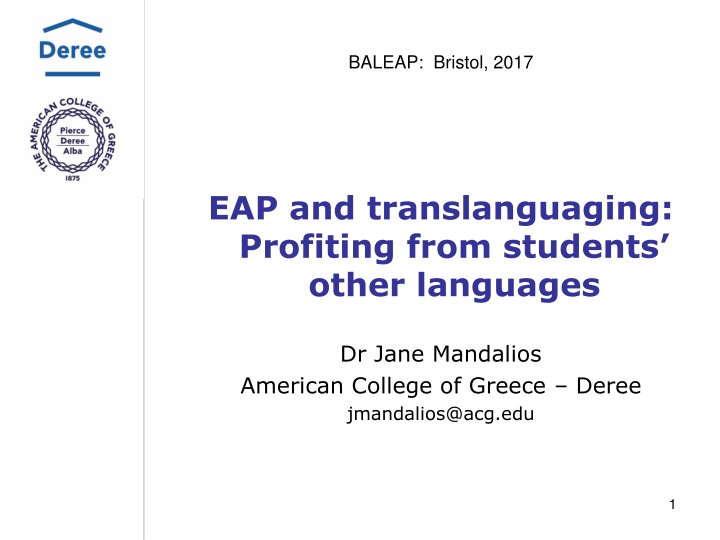
EAP and Translanguaging: Profiting from Students' Other Languages
Addressing the spread of English as a medium of instruction in tertiary education, the implications for national identity, teaching practices, and student access. Challenges to multilingualism and multiculturalism within the EU policy and the ongoing controversy over the use of students' first language in education.
Download Presentation

Please find below an Image/Link to download the presentation.
The content on the website is provided AS IS for your information and personal use only. It may not be sold, licensed, or shared on other websites without obtaining consent from the author. If you encounter any issues during the download, it is possible that the publisher has removed the file from their server.
You are allowed to download the files provided on this website for personal or commercial use, subject to the condition that they are used lawfully. All files are the property of their respective owners.
The content on the website is provided AS IS for your information and personal use only. It may not be sold, licensed, or shared on other websites without obtaining consent from the author.
E N D
Presentation Transcript
BALEAP: Bristol, 2017 EAP and translanguaging: Profiting from students other languages Dr Jane Mandalios American College of Greece Deree jmandalios@acg.edu 1
The language of instruction in the University is English. All classes will be conducted in English, and students and staff are expected to use English at all times and in all interactions . 2
Overview I. Conference theme: Addressing the state of the union: Learning together II. Spread of EMI & implications for EAP: Problematizing the practice III. Translanguaging: definitions and implications IV. My study: College students views on translanguaging V. Conclusions 3
The spread of EMI in tertiary education Definitions: EMI EMI: The use of the English language to teach academic subjects in countries or jurisdictions where the first language (L1) of the majority of the population is not English (Dearden, 2015, p.2). Very rapid expansion in tertiary sector: English- taught masters programmes in Europe 560 in 2002; 6400 in 2013 (Brenn-White & Faethe, 2013) See Dearden report on 55-country study; indications of a worldwide trend. 4
The wider context English as a global language & internationalization . BUT EU policy of multilingualism/multiculturalism Challenges to standard English CALx challenges to the dominance of English 5
Implications of spread of EMI in tertiary education: Problematizing the practice Extensive & complex implications for status of L1 at national & individual level national identity implications for teachers implications for teaching issues of privilege of access for students implications for learning & learners 6
The use of the L1 Longstanding & ongoing controversy over use of L1 within mainstream education English- only movement, esp. Garcia et al s work in US. within EFL/ESL field (Hall & Cook, 2013) within tertiary EMI: multilingual and multicultural students expected to adopt language and literacy practices of a certain kind Doiz, Lasagabaster & Sierra, 2011, p.2). 7
Implications for learners Denying students preferred learning styles? Diminishing/demonising the L1 Dominance of English Reducing student competence in L1 Affecting student academic performance L1 as mediating cognitive process 8
Translanguaging the ability of multilingual speakers to shuttle between languages, treating the diverse languages that form their repertoire as an integrated system (Canagarajah, 2011, p.401) Translanguaging is the process of making meaning, shaping experiences, gaining understanding and knowledge through the use of two languages (Baker, 2011, p.288). Translanguaging refers to the act of languaging between systems that have been described as separate, and beyond them. As such, translanguaging is transformative and creates changes in interactive cognitive and social structures Finally, in its transdisciplinarity, it enables us as speakers to go beyond traditional academic disciplines and conventional structures, in order to gain new understandings of human relations and generate more just social structures, capable of liberating the voices of the oppressed . (Garcia & Li, 2014, p.42). other languages are resource, not a hindrance natural behaviour 9
Historical development of translanguaging studies Phrase coined in Welsh ( trawsieithu ) by Williams 1980s in context of Welsh education; alternating languages of input & output; Emergence & acceptance of belief/ understanding that bilingualism could be personally, socially, culturally, politically, linguistically beneficial in Wales Development of bilingual education (Canada, US) Development of concept of additive vs subtractive bilingualism; work on code-switching Development of CLIL (Content and Language Integrated Learning) classrooms 10
1. Translanguaging is the language ideology that takes bilingualism as the norm 2. Translanguaging is a theory of bilingualism based on lived experiences. As such, it posits that bilinguals do not separate their languages into discrete systems, but rather possess one integrated repertoire of languaging practices from which they draw as they navigate their everyday bilingual worlds. 3. Translanguaging is a pedagogical stance that teachers and students take on that allows them to draw on all of their linguistic and semiotic resources as they teach and learn both language and content material in classrooms. Source: Mazak, C. (2017). Introduction: Theorizing translanguaging practices in higher education. In C. Mazak and K.S. Carroll (eds.). Translanguaging in higher education: Beyond monolingual ideologies, (pp.1-10). Bristol: Multilingual Matters. 11
4. Translanguaging is a set of practices that are still being researched and described. It is not limited to what is traditionally known as code-switching , but rather seeks to include any practices that draw on an individual s linguistic and semiotic repertoires (including reading in one language and discussing the reading in another, and many other practices [ ..] 5. As such, translanguaging is transformational. It changes the world as it continually invents and reinvents languaging practices in a perpetual process of meaning-making. The acceptance of these practices of the creative, adaptable, resourceful inventions of bilinguals transforms not only our traditional notions of languages , but also the lives of bilinguals themselves as they remake the world through language. 12
My Study (Phase 1) Context - - Private English-medium university in Greece 2800+ students, majority Greek L1; others from variety of L1s, incl English Wide range of liberal arts majors Purpose (phase 1) Explore student preferences for language use as they work on writing projects in their disciplines Discussing assignments before/while/after writing Writing in L1 during prewriting stages Use of dictionaries Use of translation Discussing with teacher - 13
Methodology (phase 1) Initial sample 35 sts from across the majors Questionnaires & interviews after working collaboratively in class on written assignments, both pre & post writing Quantitative findings 1. Clear preference for translanguaging when discussing assignments with others: 82% in prewriting stage (generating ideas, planning) 53% during writing phase 82% after writing (peer feedback) 14
2. Substantial number wanted to discuss with teacher in L1 (47%) 3. Little preference for writing in L1 eg outlines, or assignment itself (15%) or translating written texts into L1 (29%) 4. 55% used bilingual dictionaries/translators 15
Qualitative findings: Positive view of translanguaging -More efficient I can get my point across more easily and I don t waste space and time .. So I can concentrate on discussing the real matter of the topic without being limited by language barriers I can process and go through a bigger amount of information I brainstorm easier! I mainly use my first language only when speaking about my assignments I ve been all my life thinking in Greek. It s more fluent for me. I can think faster than any other language. In other languages I have to think twice to find the right words while in Greek it comes naturally. 16
- Comfortable/confidence When it comes to discussion about my topic I feel more comfortable using my first language because I am able to be more explanatory I feel comfortable and confident - Effective when the research it will be more advanced and terms are more analytic, it s more efficient to use my first language to understand better what the paper expresses it helps me sometimes to better understand some meanings or to better explain an idea It is very helpful for improving my arguments and organisation of the assignment I use in my paper French-English in order to improve my vocabulary 17
- Evidence of translanguaging I may use sources that are Greek or even French, and this makes it much more interesting Although the first language I have learned was French, shortly followed by Greek, I later focussed on English. The strange result is I think in a mixture of English/Greek. English is by far my most proficient language I have learned to work with both, but lately I predominantly work in English Awareness of no-L1 rule Personally I do not have a problem in using my first language while working on assignments with other people I am feeling comfortable, but it is the wrong way to learnt the appropriate English, so I am trying to use only English because in my native language we have different way for writing Most people will use English if they have to (eg the professor is near them!) 18
Qualitative findings: Preference for L2 Developing competence in L2 Obviously using my mother tongue is easier for me to communicate and exchange ideas, but I would prefer to use English since I am studying in an English college It s more convenient and easy to use my first language but as the time goes by I get fully used to using English The more I work around my ideas in English, the easier it is to eventually articulate them effectively and accurately in English 19
Qualitative findings: Preference for L2 May cause confusion It would probably end up confusing me because when writing an assignment in English I need to point out my arguments in English because of the many differences (cultural, in vocabulary and syntax), the use of Greek or the exact translation rarely helps me sometimes it distracts my thoughts and it struggles me to put them again in order I believe that when translating one language to the other some basic concepts might be lost in translation . So I think it s better to stick to the language I m working on . [nb: ALL students that participated in study were observed to translanguage in their collaborative discussions!] 20
Conclusions from reading and research 1. Clear evidence that translanguaging features in student EMI tertiary experiences. Clear evidence of their wish to use it. Clear evidence that they find it helpful. However, monolingualism still dominates as the required pedagogical approach. Little/no attention given to if a multi-lingual or translanguaging approach is desirable or how it can be exploited. Further research: extend this study to larger sample; explore teacher attitudes; on EMI in general 2. 3. 4. 5. 6. 21
Further Reading Canagarajah, S. (2011a). Translanguaging in the classroom: Emerging issues for research and pedagogy. Applied Linguistics Review, 1-28. doi:10.1515/9783110239331.1 Creese, A., & Blackledge, A. (2010). Translanguaging in the Bilingual Classroom: A Pedagogy for Learning and Teaching? The Modern Language Journal,94(1), 103-115. doi:10.1111/j.1540-4781.2009.00986.x CUNY-NYSIEB (City University of New York New York State initative on emergent bilinguals). (2016). http://www.cuny-nysieb.org/ Garcia, O. (2014). TESOL translanguaged in NYS: Alternative perspectives. NYS TESOL Journal, 1(1), 2-10. http://www.journal.nystesol.org/jan2014/2garcia.pdf Garcia, O., & Li, W. (2014). Translanguaging: Language, bilingualism and education. Basingstoke: Palgrave Macmillan. Hall, G., & Cook, G. (2013). Own-language use in ELT: Exploring global practices and attitudes. London: British Council. Retrieved from http://www.teachingenglish.org.uk/sites/teacheng/files/C448%20Own%20Language%20us e%20in%20ELT_A4_FINAL_WEB%20ONLY_0.pdf Lewis, G., Jones, B., & Baker, C. (2012). Translanguaging: Developing its conceptualisation and contextualisation.Educational Research and Evaluation, 18(7), 655-670. doi:10.1080/13803611.2012.718490 Lewis, G., Jones, B., & Baker, C. (2012). Translanguaging: Origins and development from school to street and beyond. Educational Research and Evaluation, 18(7), 641-654. doi:10.1080/13803611.2012.718488 Mazak, C., & Carroll, K. S. (2017). Translanguaging in higher education: Beyond monolingual ideologies. Bristol: Multilingual Matters. 22

